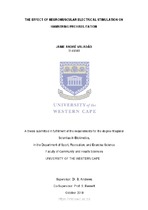| dc.description.abstract | BACKGROUND: Hamstring injuries remain a growing concern within a large
variety of sports from the elite athlete to the weekend warrior. A copious
amount of research has been performed in an attempt to reduce these
injuries. The aim of this study was to understand the changes in lengthened
state eccentric strength of the hamstrings following four separate protocols.
METHODS: A quantitative research approach, using a true experimental
design, was adopted for this study. A convenience sample of non-sedentary,
35 male participants, between the ages of 18 and 35 within the City of Cape
Town was used. Participants were randomly allocated to one of four groups
namely; Control group (C), resistance training alone (RT), neuromuscular
electrical stimulation alone (NMES), or NMES superimposed with RT
(NMES&RT). Participant’s eccentric hamstring strength was tested in a
lengthened state, on the Biodex system 4 Pro™ for the pre- and post-test.
The intervention spanned over four weeks. SPSS version 25 was used for
data analysis.
RESULTS: All groups demonstrated a mean increase in relative peak torque.
However, a repeated-measures analysis of variance (ANOVA) showed no
interaction effect (p = 0.411) between the four groups. Further analysis using
Magnitude-based inferences (MBI), to identify the magnitude of changes,
showed a small positive effect for both the NMES and NMES&RT group when
compared to the C and RT groups.
CONCLUSION: Although there are no statistically significant differences
between the four groups employed in this study (C, RT, NMES, NMES&RT),
NMES and NMES&RT did show small positive effects compared to C and RT
with a very low likelihood of negative effects. Thus, using NMES either alone
or superimposed with resistance training will be beneficial for trained athletes
but it is not a necessity and the use of specific resistance training may be just
as effective. | en_US |

